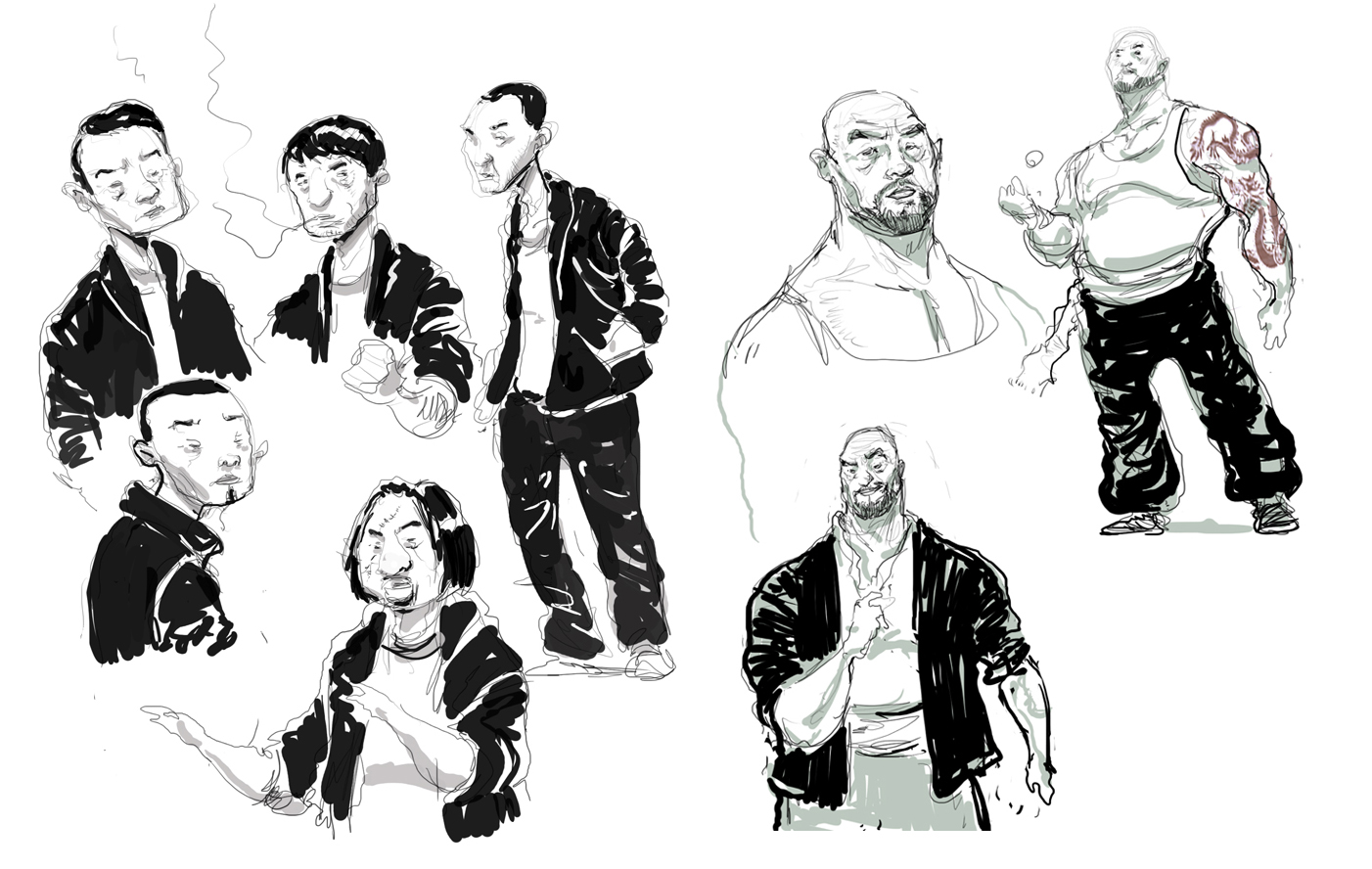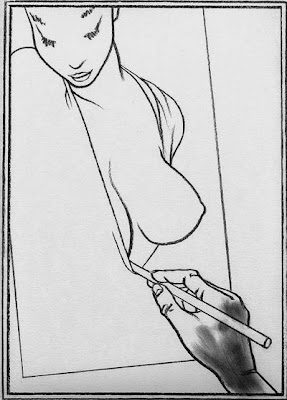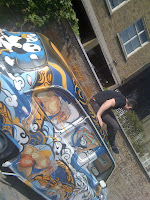Thank you for all your comments and warm welcome. Here is my second post on OIC, to answer Mike's questions to my last post. Thank you for asking and giving me the opportunity to write about children's book publishing. I hope other illustrators out there who have illustrated children's book can contribute to this post, provide other insights on publishing, so that we can learn and help one another grow.So far, I have worked with only one publisher for all the 6 big format books for educators. I can only share with you what I have learned over the course of becoming a children's book illustrator. I will shed a little more light on the subject after I have worked with and learned more from a few more others in the future. I am in the midst of getting my first children's trade book assignment with another publisher. It's gonna be an exciting journey. Wish me luck.In the meantime, here are random thoughts based on my personal knowledge and experiences in publishing.Mike: Since you have done quite a few books already - can you share some pointers ( in a new post on illustrating for publishers? )1. Contract - always ensure you and the publisher establish terms of working together and get a written agreement prior to commencing any work to protect your interests as well as the publisher's. Illustrating a book can take you weeks and months of work on research and development. If you start a project without any written confirmation of some sort, your time and effort may not be profitably spent (unless you are doing it purely for the experience). So, don't be shy to ask for one. It will set you apart as being ethical and professional. A contract should specify clearly your responsibilities, development timeline, terms and conditions, the publisher's obligations, payment terms, rights assigned to each party, etc. If you are uncertain about publishing contract and the different rights to your illustrations for the books that you should get or retain, do take the time to find out over the web, through books, local publishing associations or talk to other published illustrators and authors to get the information. Below are some links. If you are partnering with a writer on a book, ensure you have a written collaboration contract.A word of caution: Most publishers overseas prefer to have the manuscript or illustrated proposal submitted individually instead of partnership.They felt that it is better to partner an unpublished illustrator with a published writer (and visa versa) to increase the opportunity of getting noted in the sea of children's books. Also, it is the expertise of the editors and art directors to find the perfect match. So, in fact, illustrators and writers are silent partner. Illustrators normally only communicate with the editor and art director. Whereas here, things can work the other way around. Publishers somehow do accept creators to come as a "package" and writers do approach illustrators themselves.Some illustrators overseas have art reps to help them handle the business aspect including negotiate contracts and promote the artists. With an art rep, the illustrator can have more time to create. However, you do not need an artist's rep to get published.Last thought on contract, I strongly advise that you do your best to avoid "Work for hire" or "All rights transferred" type of jobs and try to negotiate for better terms (advance payment, royalties, copyrights, exclusive yet limited rights deal) instead. While it is hard to get published, illustrators should not work for free. Just be reasonable with what you ask.2. Do your homework on the publishers (apply to both local and international publishers, more towards overseas publishing house) - the type of books they have published, their experience in children's book publishing, what support can you get to promote and market your books, who are the editors and art directors (for work samples and manuscript submission) in the publishing house, what are the guidelines for submission or review (do you need an agent or art rep to represent you), etc.3. Getting jobs - Prior to getting the first book assignment, I did some samples that may suit children books and put them on my blog. Since I read to my kids and am a big fan of children's stories, it is natural for me to pay attention to the illustrations and sometimes study them. I have been very fortunate in many ways to be founded by a very creative client from Belgium whom I do greeting cards for and a publisher whom I love working with and develop my portfolio with. They gave me a lot of freedom to my creation and this freedom allows me to explore various possibilities to develop the style, characters, settings, etc, appropriate for the story I was working on. Even though the pay is nothing like any commercial assignment I have done before, the opportunity to illustrate for children is gold. Every single book is a stepping stone for me to produce better work, challenge my abilities and to enter into the bigger and wider children's book publishing circle. I hope I will eventually see some proper rewards coming along. As for now, I will keep drawing for the love of it.4. Read - read to learn from others. In Singapore, children's book illustrating is not as established as countries like the UK, America, Australia, Italy and even Taiwan and Japan. A big chunk of my knowledge comes mostly from reading books from those countries. Well established illustrators inspire me to build a unique portfolio that will stand out from the rest and stimulate me to pushing the standard of locally published picture books.5. Useful resources on the Internet:There are tons of websites out there where you can learn about children's book publishing. The only thing is that the info is either from the States, the UK, Australia or somewhere in Europe where things are done in a lot more professional and established manner. Nevertheless, they are useful information and well developed guidelines to learn from. It is also extremely resourceful for illustrators who want work with oversea publishers and authors.The Purple CrayonVerla KayThe Society of Children's Book Writers & IllustratorsDeborah White on writing and publishingPublishing Central on Contracts and other informationCopylawGraphic Artists Guild6. On production: Not all publishing houses have experienced book designers, art directors and production teams handling production. Whenever possible, request to see the final layout and colour separations for your book. Also take note that it is the publisher's job to drum scan your artwork if they are not done digitally.
Some advice and words of encouragement given by reputable publishers I met at conferences.1. For first time illustrators: Keep your day jobs - for obvious reason - it will pay your bills!2. The publishing world is a tough world to be in, it's tougher in the children's picture book sector and it does not get easier even after one get published. Editors in a mid- to large-sized publishing house gets upwards of 5000 unsolicited submissions a year. About 95% are rejected right off and of the 5% left, some are queries for which the editors request entire manuscripts. Others are manuscripts submitted in their entirety, and these go on to the next stage of the acquisitions process. The end result is that 1-2% of unsolicited submissions are actually purchased for publication. For illustrators, no matter how talented you are, there are literally thousands of other talented illustrators out there looking for the same break you are. The most important part of getting that crucial break, and getting a job, as an illustrator of children’s books is to do your homework - (like any business) research your market, build a portfolio of your best work, promote yourself. It's a lot of work to get started with, but don't give up.3. Learn as much as you can about how to submit your work and how the business works before you start contacting an art director or editor. Most editors and art-directors strictly say NO to emails and calls. So again, research.4. Rejection is part and parcel of the business.
5. Keep as much rights as you can for your illustrations.
Mike: How much time was spent working on this a project? Usually I have to produce 10 to 20 paintings within 4 to 12 weeks from research, sketch to finish. I work from 6 to 8 hours a day to as much as 18 hours depending on the deadlines. I am very meticulous with details for most of my illustrations so I may take longer time than others to finish a piece of illo. For your information, a trade picture book has at least 32 pages of illustrations whereas educational books varies from 8 to 20 pages depending on the reader's level.
Mike: Explain the process?All artists work differently. This is roughly how I work.
The publisher will email me a list of books, with complete manuscript, for me to pick and choose the story or stories I want to do. After selecting and getting a written confirmation my choice from the publisher, I will start planning. Therefore, work out the technical specs (no. of pages, colour requirement, size, deadlines, submission method, etc) and my personal schedule (very important for I am also a fulltime "maidless" mum). After that, I will begin working on the book by reading the manuscript over and over again to get a good feel about the story and subject. Then I will do some research related to the characters, setting, theme - anything that take me into the story and better understand the book in order to narrate it visually.
While researching and gathering reference materials, I may brainstorm a bit and scribble several preliminary and rather messy thumbnails or notes for each page, whatever that come to mind to jump start the creative process. I will also explore layouts, text placement, perspective and think of possible style and colour scheme. I usually spent a couple of weeks on researching, doodling and thinking.
Once I have enough sketches, I will move on to the next development phrase which I find quite similar to story-boarding for TVC. I create a template of spreads set to a reduced proportion of the actual book size with InDesign. I print them out, number the spreads and sketch out with slightly more details the ideas that I had previously scribbled in the right order. These sketches are called roughs.
If the story centers around a character or two, I will develop some studies of the character(s). If the story features different things (like the books that I did on animals), I will sketch out the various objects - sometimes I start with the easy one, so I can move on to the next more quickly. After that, I can work on other aspects of the illustrations. By then, I should have a proper composition of each illustration. From there, I can make an actual size dummy book out of the roughs. The dummy will give me the feel and flow of how the actual book would look like.My publisher has never asked me to show them any thumbnails, development sketches, roughs or dummies, but it is a practice in other publishing houses to see the roughs and dummy book. The editor, art-director, and maybe author as well, will discuss over the sketches. Then the illustrator will get back to do whatever changes, refine the roughs, and ensuring consistency throughout the book. Sometimes it may take several rounds of revision before a final go-ahead is given.
 After getting the ok signal, I will transfer one or two sketches to watercolour paper and try out a colour version. Once I am satisfied with the tested piece, I will show the publisher for feedback. If there is no changes, I can then proceed to paint the rest.
After getting the ok signal, I will transfer one or two sketches to watercolour paper and try out a colour version. Once I am satisfied with the tested piece, I will show the publisher for feedback. If there is no changes, I can then proceed to paint the rest.My job is considered done after submitting all the illustrations. However, I do take every effort to involve in production to ensure the finishing product is perfect.
 Mike: Is it purely manual? Any photoshop?I like and enjoy working with traditional medium so I prefer to paint my illustration in the old school ways. I use photoshop mainly for three purposes - colour adjustment, sometimes to strip in the background and clean-up for F/A.
Mike: Is it purely manual? Any photoshop?I like and enjoy working with traditional medium so I prefer to paint my illustration in the old school ways. I use photoshop mainly for three purposes - colour adjustment, sometimes to strip in the background and clean-up for F/A.I think I have said a lot in the end. I hope the info is useful.



























 After getting the ok signal, I will transfer one or two sketches to watercolour paper and try out a colour version. Once I am satisfied with the tested piece, I will show the publisher for feedback. If there is no changes, I can then proceed to paint the rest.
After getting the ok signal, I will transfer one or two sketches to watercolour paper and try out a colour version. Once I am satisfied with the tested piece, I will show the publisher for feedback. If there is no changes, I can then proceed to paint the rest. Mike: Is it purely manual? Any photoshop?
Mike: Is it purely manual? Any photoshop?


